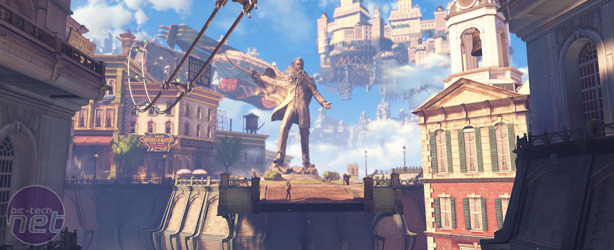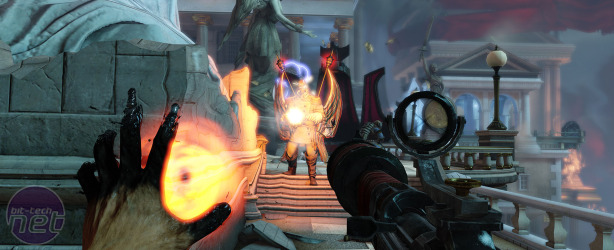Bioshock Infinite Performance Analysis
April 23, 2013 | 08:29
Companies: #bit-tech #irrational-games

Bioshock Infinite Performance Analysis
Having gotten used to Unreal Engine 3 games being about as demanding as a negotiator from the neutral planet, we were perversely pleased to find that Bioshock Infinite is a tricky game to run at its best even on expensive hardware at 1,920 x 1,080. The GTX 690 4GB and GTX Titan 6GB are predictably out in front by some margin at all three resolutions, but further down the field it quickly gets very competitive.
The GTX 680 2GB just pips the HD 7970 3GB GHz Edition with its minimum frame rate of 66fps at 1,920 x 1,080, while the HD 7950 3GB and GTX 670 2GB are deadlocked with a minimum frame rate of 60fps each. The next step down is a big one for AMD though, with the HD 7870 2GB's minimum frame rate of 42fps slower than both Nvidia's GTX 660 Ti 2GB and GTX 660 2GB, which produce minimum frame rates of 52fps and 45fps respectively.
Nvidia's new boy, the GTX 650 Ti Boost 2GB, also topples its nemesis, the HD 7850 2GB thanks to a 3fps minimum frame rate advantage. While the lesser cards might look disappointing at the bottom of the graph, we can extrapolate our finding from the GTX 680 2GB and HD 7970 3GB at different detail settings to see that, should you drop detail settings down, even these low-end cards can produce playable frame rates. Going from Ultra to medium for example comfortably doubles the frame rate, whilst retaining visual extras such as simple self-shadowing and anti-aliasing. It's not absolutely guaranteed that performance will scale in exactly the same way on slower hardware, but we still feel confident suggesting you'll find playable settings on these cards.
Upping the resolution made no difference to the running order, although this time the GTX 680 2GB and HD 7970 3GB are evenly matched with a minimum frame rate of 37fps each. Again the GTX 670 2GB and HD 7950 Boost are deadlocked too, although the HD 7870 2GB again underwhelms with slower performance than the cheaper GTX 660 2GB.
Finally at three-screen 5,760 x 1,080 the HD 7970 3GB comes good, comprehensively outpacing the GTX 680 with a minimum frame rate of 20fps; a 40 per cent advantage over the Nvidia card. Disappointingly, the GTX 690 4GB suffered from some severe driver issues here, with a pitiful minimum frame rate of just 7fps despite a healthy 34fps average. That leaves the GTX Titan to take top honours, it's 6GB of GDDR5 seemingly mastering the ultra-high resolution to offer a 60 per cent performance lead over the HD 7970 3GB GHz Edition.
Conclusion
At the high end at least, the GTX 680/HD 7970 and GTX 670/HD 7950 are very evenly matched in Bioshock Infinite, with both pairs of cards performing within a few frames of each other regardless of resolution; it's only at 5,760 x 1,080 that the 7970 proves tangibly quicker. Further down the stock though, the HD 7870 2GB is disappointingly slower than both of Nvidia's GTX 660-series cards, with the £150 GTX 660 2GB quicker than the dearer Radeon card. This is repeated with the GTX 650 Ti Boost 2GB quicker than the HD 7850 2GB and GTX 650 Ti 1GB faster than the pricier HD 7790 1GB. While buying an HD 7870 might net you Bioshock for free then, a GTX 660 2GB will offer that bit more performance for less.
MSI MPG Velox 100R Chassis Review
October 14 2021 | 15:04











Want to comment? Please log in.